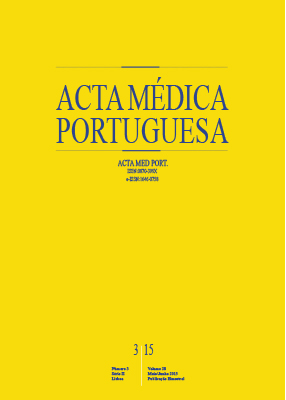Doença Meningocócica Invasiva: Aplicação do Base Excess and Platelets Score numa Unidade de Cuidados Intensivos Pediátricos Portuguesa
DOI:
https://doi.org/10.20344/amp.5773Palavras-chave:
Criança, Cuidados Intensivos Pediátricos, Doença Meningocócica, Portugal, Prognóstico, Valor Preditivo dos Testes.Resumo
Introdução: A infeção meningocócica tem uma elevada mortalidade e morbilidade. Recentemente foi desenvolvido um score de prognóstico para a doença meningocócica invasiva em idade pediátrica, baseado na contagem plaquetar e no excesso de base - o Base Excess and Platelets Score. O objetivo principal desde estudo foi avaliar a precisão prognóstica do Base Excess and Platelets Score em doentes admitidos em cuidados intensivos pediátricos por doença meningocócica invasiva.
Material e Métodos: Estudo observacional, com colheita de dados retrospetiva, que incluiu um período de 13,5 anos (01/2000 a 06/2013). Foram analisados: mortalidade por doença meningocócica invasiva e fatores associados (disfunção de órgão e falência multi-órgão). Foi calculado o Base Excess and Platelets Score de forma retrospetiva, para avaliar a sua precisão na predição da mortalidade e foi comparado com o Paediatric Risk of Mortality e Paediatric Index of Mortality2.
Resultados: Foram admitidas 76 crianças com doença meningocócica invasiva. O tipo de disfunção mais frequente foi a cardiovascular (92%), seguida da hematológica (55%). Cumpriram critérios de falência multi-órgão 47 doentes (62%). A mortalidade global foi de 16%. A disfunção neurológica e a renal foram as que apresentaram uma maior associação com a mortalidade, odds ratio ajustado 315 (26 - 3 804) e 155 (20 - 1 299). Após aplicação das curvas receiver operating characteristic, o Base Excess and Platelets Score tinha uma
area under curve de 0,81, o Paediatric Index of Mortality2 de 0,91 e o Paediatric Risk of Mortality de 0,96.
Discussão: O Base Excess and Platelets Score apresentou uma boa precisão apesar de não tão elevada como o Paediatric Index of Mortality2 ou o Paediatric Risk of Mortality.
Conclusões: O Base Excess and Platelets Score pode ser útil como indicador prognóstico na doença meningocócica invasiva, por apresentar uma elevada sensibilidade e especificidade e ser objetivo e rapidamente disponível na admissão.
Downloads
Downloads
Publicado
Como Citar
Edição
Secção
Licença
Todos os artigos publicados na AMP são de acesso aberto e cumprem os requisitos das agências de financiamento ou instituições académicas. Relativamente à utilização por terceiros a AMP rege-se pelos termos da licença Creative Commons ‘Atribuição – Uso Não-Comercial – (CC-BY-NC)’.
É da responsabilidade do autor obter permissão para reproduzir figuras, tabelas, etc., de outras publicações. Após a aceitação de um artigo, os autores serão convidados a preencher uma “Declaração de Responsabilidade Autoral e Partilha de Direitos de Autor “(http://www.actamedicaportuguesa.com/info/AMP-NormasPublicacao.pdf) e a “Declaração de Potenciais Conflitos de Interesse” (http://www.icmje.org/conflicts-of-interest) do ICMJE. Será enviado um e-mail ao autor correspondente, confirmando a receção do manuscrito.
Após a publicação, os autores ficam autorizados a disponibilizar os seus artigos em repositórios das suas instituições de origem, desde que mencionem sempre onde foram publicados e de acordo com a licença Creative Commons









